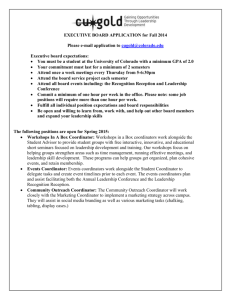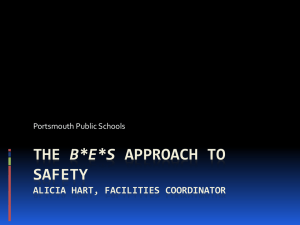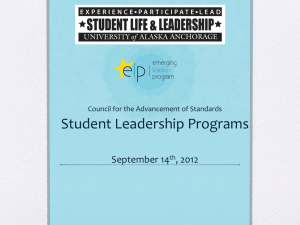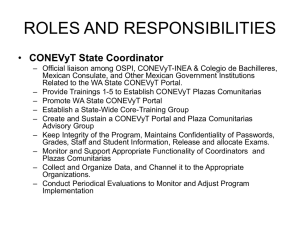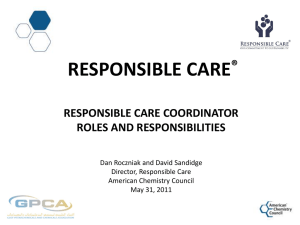in People, Process, and Technology
advertisement
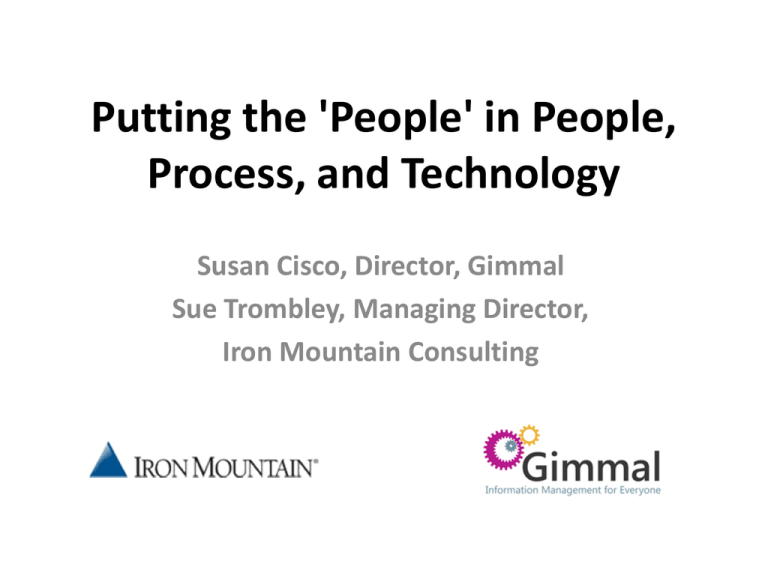
Putting the 'People' in People, Process, and Technology Susan Cisco, Director, Gimmal Sue Trombley, Managing Director, Iron Mountain Consulting Today’s Topics Unified Records Management (URM)? Records Coordinator Networks Survey Results Emerging Best Practices Q&A What is URM? • Unified Records Management enables consistent management of all records and information, physical and electronic, through their lifecycle, apply policy for retention and destruction, and simplify RM processes on a common platform Renewed Interest in Records Coordinators • As organizations move forward with URM, they are asking who will assist with the implementation of URM • Traditional “Records Coordinator” role directed at physical records: – Coordinate cleanup events – Assist with applying/releasing retention holds – Manage off-site storage and retrieval of physical information stored with third party vendors • Up-to-date guidance on Records Coordinator networks is lacking Records Coordinator Networks Survey Results Zoomerang Survey • Because of their depth of RM knowledge and experience, the survey population was CRMs • Identified email addresses for 886 of 911 active CRMs • Launched survey April 19: – Delivered 838 surveys to valid email addresses – Received 97 responses (12%) Industry Sectors (n=94) Government, Defense, Public Service 19% Utilities, Oil & Gas Banking, Finance, Insurance Professional Practices (Law Firms, Consultancies) Manufacturing, Wholesale, Retail Chemicals, Pharmaceuticals, Plastics & Metals Education, School, R&D Information Technology 18% 13% 11% Healthcare Other 2% 19% 6% 4% 4% 3% Number of Employees (n=79) 1-100 Employees 101-1,000 Employees 1,001-5,000 Employees 5% 25% 23% 5,001-15,000 Employees 15,001-30,000 Employees 30,001-50,000 Employees 20% 13% 4% 50,001-100,000 Employees More than 100,000 Employees 4% 6% 43% Definition of Records Coordinator (RC) in Survey “Serves as liaison between their department or location and records management staff and provides support for implementation of the organization's recordkeeping policies, procedures, standards, and guidelines at the department/location level.” What Name Is Used for RC Role? (n=80) Other 34% Records Liaison 20% Records Coordinator 46% When Was RC Network Established? (n=75) 1987 or earlier 1988-1998 19% 12% 1999-2004 2005-2010 2011 to present 20% 41% 8% 61% • More than half (61%) began in1999-2010 – Scandals of the early 2000s (Enron and WorldCom) – Sarbanes-Oxley Act 2002 – Amended Federal Rules of Civil Procedures 2006 – Others: FACTA, HIPAA, GLB,… RC to Staff Ratio (n=76) ACTUAL RATIO – Staff/RC 977 / 1 IDEAL RATIO – Staff/RC 625 / 1 • Number of RCs at 64% of desired state – Not a question of talent, but scale – Budget constraints – Competing priorities Is Electronic RM an RC Function? Respondents could give more than 1 response No, physical only 51% Maintain inventories of business information assets in electronic format 34% Check that large record repositories such as imaging and document management systems are properly classified for retention 30% Check that records in shared drives are properly classified for retention 26% Activate retention events for event-based retention periods such as "Termination of employment + x years" and "Expiration of contract + x years" 23% Participate in imaging feasibility studies and/or quality control of scanning operations 19% Check that email records are properly classified 17% Act as a Team Site or Site Collection Administrator for SharePoint 9% What Functions Do RCs Perform? Respondents could give more than 1 response Liaise with the organization's Records Manager/RM Officer 91% Check that physical records sent to offsite storage are properly classified and packaged 75% Coordinate activities for record cleanup events 71% Notify Records Manager/RM Officer when there is a need to revise recordkeeping policies, procedures, & guidelines 70% Coordinate record destruction activities 70% Train staff members on implementing the recordkeeping procedures 61% Interpret recordkeeping policies, procedures, and guidelines 49% Conduct or participate in RM audit activities 47% Apply/release retention holds 23% Other (i.e., compliance self-assessment, IM solution design) 18% What % of Time Is Spent on RC Role? (n=74) 1-10% 11-25% 26-50% 70% 20% 4% 51-75% 76-100% 1% 4% • 90% spend less than 26% of time – Majority (70%) spend 1% - 10% of their time in the Records Coordinator role 90% How Are RC’s Developed? Respondents could give more than one response * * Train them on the role of the Records Coordinator 76% Train them on the principles & practices of records management for both paper and electronic records 65% Make Records Coordinator function a part of each coordinator's job description 31% Make Records Coordinator function a part of each coordinator's performance appraisal 26% Train them on legal issues such as eDiscovery 27% Empower them with public support from senior management 26% No formal training given 18% Other * 23% Train them on legal issues regarding HIPAA and HITECH Regular meetings and hands-on support when needed What Tools Are Provided to RCs? Respondents could give more than one response Web-based training modules 52% Lunch & learn meetings Records management software Industry association training 48% 39% 17% Metadata management training and tools Other * 14% 32% * 6% mentioned regular internal meetings: • Annual update meetings • Monthly network meetings • Quarterly meetings with Records Management Biggest Challenge (n=71) Lack of support from executive level - “Raising awareness at the ‘C’ level that RM is critical to success; change perception from a ‘chore’ to a critical part of business continuity & acknowledge performance” Mobility of Records Coordinators, turnovers, transfers - “Probably our greatest challenge is keeping our information/directory of records coordinators up to date. We really do have hundreds of records coordinators … and the turnover is pretty large.” Records Coordinator Networks Best Practices Biggest Success (n=62) “Awareness of records management and the requirement to dispose of records in a timely and secure manner has increased dramatically. Production of video training targeted at different layers of management has brought RIM awareness to the forefront.” One very large team (5000 employees) created 3 functional teams who oversee 3 major business functional areas and are working with sites and departments to implement file plans and gather more detailed inventory lists. Biggest Success (n=62) “Their [RCs] ability to prepare their departments for the annual compliance audits and taking ownership and pride in the audit results.” “Willingness to learn, enthusiastic about wanting to clean up share drives, ready to embrace technology to streamline recordkeeping.” “Building a global 600-person community in a twoyear period, and developing training tools and communication templates for them to use with their business units.” The Commitment/Practice Divide 94% more budget 80% have formal policies 64% provide training 72% no strategic plan 63% inconsistently applied policies 15% Only audit & review Unified Records Management Establish a foundation 77% have formal, policy-driven processes to protect private information from unauthorized or inadvertent access Unify physical records 83% report that they are unable to locate hardcopy records when needed, due in large part to the fact that not all records, across all locations, are indexed Unify electronic records Only 35% say they can classify and index user-created electronic records at time of creation or later in their lifecycle Best Practices • Put the “I” in Records Coordinator by extending RC role to electronic records • Support the RC network with an online community (blogs, team site), monthly conference calls, weekly FAQ sessions, coordinator of the month recognition, multimedia training, annual objective templates, etc. Best Practices • Make RC role a part of each RC’s job description and performance appraisal; use of acknowledgment agreements • Create a “buddy” system to hedge against turnover • Extend awareness of records and information management to all employees to lighten RC’s load Case Studies • Government agency grew from 1 FTE RC to 12 in 2 years. Constant re-enforcement of risk to leadership through scenarios, real and imagined • Increased networking with IT – including input to technology selection and implementation 26 Case Studies • Global corporation addressed media neutral records management through creation of records coordinator and IT representative pairs for each operating company/business unit • Partnership increases RC erecords/technology understanding 27 Where Do We Go From Here? RC strategy Focus on unification of paper and electronic records Change management Training On-going communication Questions & Answers THANK YOU! 29
